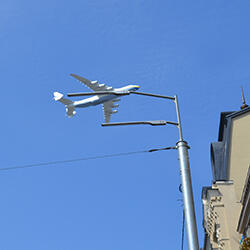 TCUP Director Emily Channell-Justice is in Ukraine for a month to conduct research for her project on internally displaced persons. She'll be sending notes about her activities, starting with reflections on the Crimea Platform summit and Ukraine's Independence Day activities.
TCUP Director Emily Channell-Justice is in Ukraine for a month to conduct research for her project on internally displaced persons. She'll be sending notes about her activities, starting with reflections on the Crimea Platform summit and Ukraine's Independence Day activities.
On August 24, 2021, Ukraine celebrated the 30th anniversary of its independence from the Soviet Union. Thousands of people gathered around Maidan Nezalezhnosti (Independence Square) and Kyiv’s main street, Khreshchatyk, to watch the military parade and listen to President Volodymyr Zelensky’s remarks on the occasion. I stood among several generations of Ukrainians at the intersection of Khreshchatyk and Taras Shevchenko Boulevard to watch the parade and celebrate Ukraine’s independence.

The year 1991 was not the first time Ukraine declared itself an independent state, with several historical precedents, such as the Ukrainian People’s Republic that was declared in 1918. Nor was the 1991 declaration definitive in charting Ukraine’s independent course; the past 30 years have been full of challenges to Ukraine’s statehood and sovereignty, requiring the country’s leaders and citizens to reiterate their commitment to Ukraine’s independence. Most recently, in 2014, the Euromaidan protests ousted pro-Russian president Viktor Yanukovych in favor of a European future for Ukraine. In response to this strong statement of a future apart from the Russian Federation, Russian president Vladimir Putin took advantage of the chaos of the moment to annex the Crimean Peninsula and, later in 2014, to support separatist movements in the regions of Donetsk and Luhansk.
This year, the week leading up to August 24th was filled with various events around the country marking this important anniversary. From concerts to art and historical exhibitions, as well as the internationally recognized Crimea Platform summit, these festivities highlighted Ukraine’s unique contributions and developments since 1991. With the war in Eastern Ukraine still ongoing, the 30th anniversary celebrations featured many examples of Ukraine’s military strength, which has improved dramatically since 2014, in part thanks to the United States (and other Western allies) providing lethal and non-lethal military aid. The military parade on August 24 also highlighted Ukraine’s own advancements, such as the new An-225 “Mriya” cargo plane, which performed a low flyover along with several other aircraft. A citizen-organized March for the Defenders of Ukraine — ‘defenders’ including everyone from volunteer soldiers to medical teams—took place after the official military parade.

I could not help reflecting on the only other time I was in Ukraine for Independence Day—in 2004, the very first time I visited Ukraine. I had been in the country for a week or so, with little knowledge of either Ukrainian or Russian and fully dependent on my host family to navigate daily life. We attended the festivities on Maidan Nezalezhnosti, featuring a concert from Eurovision winner Ruslana. I remember the huge crowds trying to cram into the already packed metro cars and my fear that I would be separated from my host family and unable to find my way to their home. Just a few months later, this same square would be packed with protesters demanding new elections after Yanukovych was announced the winner of the presidency. They would stay in the square for two months until their demands were met and new elections were held.
The Orange Revolution of 2004 and the Euromaidan mobilizations of 2014 are just two examples of Ukrainians showing their commitment to democracy. As someone who was present for the entirety of the latter protests, I would not contend that these events were a perfect form of civic participation that represented all Ukrainians, but it is essential to recognize that in both cases, people came into the streets to support democracy and to preserve their independence. Independence in Ukraine is not treated as a given. Indeed, it cannot be.